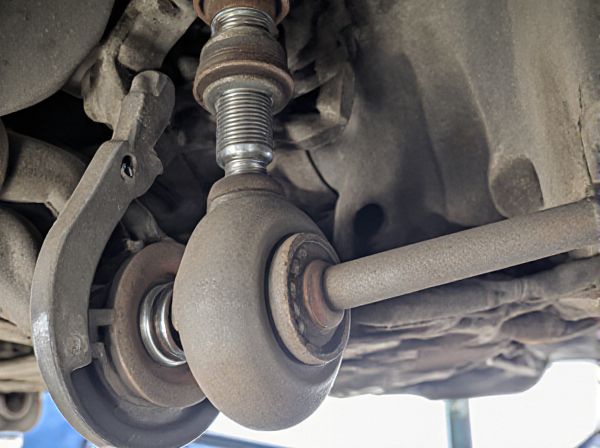
Photo illustration: Rack and Pinion vs Recirculating Ball
Rack and pinion steering systems provide direct and precise control by converting rotational motion into linear motion, ideal for responsive handling. Recirculating ball systems use a series of ball bearings to reduce friction and are better suited for heavy-duty vehicles requiring higher steering effort. Your choice depends on the driving experience you prefer and the specific vehicle application.
Table of Comparison
| Feature | Rack and Pinion | Recirculating Ball |
|---|---|---|
| Steering Mechanism | Direct gear-tooth rack and pinion system | Gear and worm with recirculating ball bearings |
| Precision | High precision and responsive steering | Less precise, suitable for heavy vehicles |
| Common Usage | Passenger cars and light vehicles | Trucks and heavy-duty vehicles |
| Complexity | Simple design, fewer parts | More complex, multiple components |
| Maintenance | Low maintenance requirements | Higher maintenance due to complex parts |
| Durability | Moderate durability under normal use | Highly durable, handles heavy stress |
| Steering Feel | Direct and sharp feedback | Smoother but less responsive |
| Cost | Generally lower cost | Higher cost due to complexity |
Introduction to Steering Mechanisms
Rack and pinion steering mechanisms directly convert rotational motion of the steering wheel into linear motion, offering precise control and responsiveness commonly used in modern passenger vehicles. Recirculating ball systems utilize a series of ball bearings within a worm gear assembly to reduce friction and provide smoother steering, often found in heavier trucks and older vehicles. The choice between these mechanisms influences vehicle handling, steering feel, and maintenance requirements.
What is Rack and Pinion Steering?
Rack and pinion steering is a mechanism that converts the rotational motion of the steering wheel into linear motion to turn the vehicle's wheels. It consists of a circular pinion gear engaging a linear rack gear, providing precise and responsive steering control commonly used in modern cars. This system is favored for its simplicity, direct steering feel, and efficient power transfer compared to the recirculating ball steering mechanism.
How Recirculating Ball Steering Works
Recirculating ball steering operates by using a worm gear inside a block that moves a sector gear connected to the steering linkage, reducing friction through ball bearings that continuously circulate around the gear. This mechanism allows for smoother and more precise steering control, especially in heavy-duty vehicles, by efficiently transferring the rotational motion of the steering wheel into linear motion. Unlike rack and pinion systems, recirculating ball steering provides greater durability and torque handling, making it ideal for larger trucks and off-road vehicles.
Key Differences Between Rack and Pinion and Recirculating Ball
Rack and pinion steering systems provide direct, responsive handling by converting the rotational motion of the steering wheel into linear motion, ideal for passenger cars. Recirculating ball steering uses a worm gear and ball bearings to reduce friction and provide smoother steering in heavy-duty vehicles and trucks. Key differences include precision and feedback, with rack and pinion favored for accuracy and simplicity, while recirculating ball offers durability and easier handling under high load conditions.
Advantages of Rack and Pinion Systems
Rack and pinion steering systems provide precise and direct control, offering improved responsiveness and feedback compared to recirculating ball designs. Their simpler construction results in lighter weight and reduced maintenance requirements, enhancing overall vehicle efficiency. This system is especially advantageous in passenger cars and performance vehicles where steering accuracy and simplicity are prioritized.
Benefits of Recirculating Ball Steering
Recirculating ball steering offers superior durability and reduced steering effort, making it ideal for heavy-duty vehicles and off-road applications. Its design minimizes friction and wear by circulating ball bearings between the steering shaft and gear, resulting in smoother and more precise steering control. Enhanced load distribution in recirculating ball systems improves longevity and reduces maintenance compared to rack and pinion setups.
Common Applications and Vehicle Types
Rack and pinion steering systems are predominantly used in passenger cars and light trucks due to their precise control and compact design, making them ideal for urban and highway driving. Recirculating ball steering systems, found mainly in heavy-duty trucks, SUVs, and off-road vehicles, provide durability and the ability to handle higher steering loads under tough conditions. These application differences highlight the rack and pinion's preference for responsiveness in smaller vehicles versus the recirculating ball's robustness in larger, heavier vehicles.
Performance and Handling Comparisons
Rack and pinion steering systems deliver precise, responsive handling by directly translating driver input to wheel movement, making them ideal for sporty and performance vehicles. Recirculating ball systems offer smoother, more durable steering with reduced feedback, favored in heavy-duty trucks and off-road applications where robustness outweighs sharp responsiveness. The rack and pinion setup excels in performance due to minimal friction and quick response, whereas recirculating ball steering prioritizes longevity and load-bearing capacity over nimble handling.
Maintenance and Longevity Considerations
Rack and pinion steering systems require less frequent maintenance due to their simpler design and fewer moving parts, resulting in lower long-term repair costs. Recirculating ball steering systems, commonly found in heavy-duty vehicles, demand regular lubrication and inspection to prevent wear of the ball bearings and gearbox components. The longevity of rack and pinion setups typically surpasses recirculating ball systems in passenger cars, while recirculating ball mechanisms offer enhanced durability under heavy load conditions.
Choosing the Best Steering System for Your Vehicle
Rack and pinion steering offers precise handling and a direct connection between the steering wheel and the wheels, making it ideal for sports cars and light vehicles seeking responsive control. Recirculating ball steering, designed with a series of ball bearings to reduce friction, provides durability and strength, which is advantageous for trucks and heavier vehicles requiring robust performance. Evaluating vehicle weight, driving conditions, and desired steering feel helps determine whether the rack and pinion's accuracy or the recirculating ball's toughness best suits your driving needs.
 caratoz.com
caratoz.com